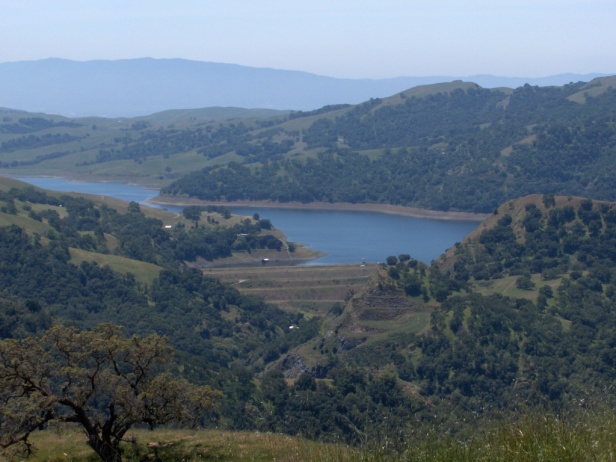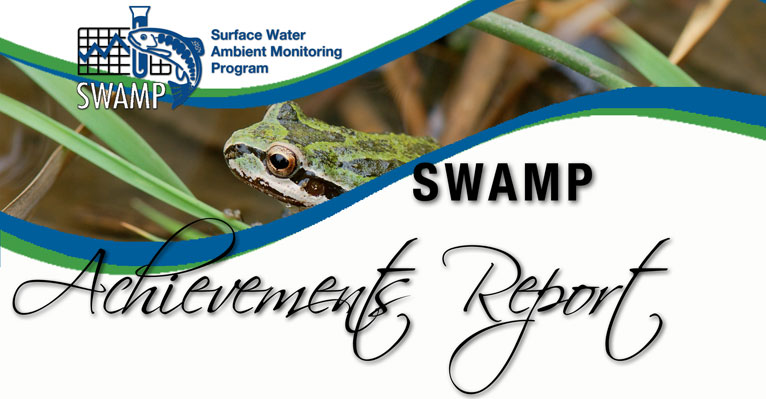SWAMP Achievements Report - Comparability
SWAMP Achevements Quick Links
The U.S. Environmental Protection Agency (EPA) defines comparability as "the measure of confidence with which one data set, element, or method can be considered as similar to another". Comparability is an especially important consideration with SWAMP data, which represents a wide variety of objectives, organizations and procedures over many years, both governmental and non-governmental.
SWAMP works to collect, manage and disseminate accurate environmental data of known quality in order to facilitate effective management decisions. These activities are carried out with programmatic support from the SWAMP Information Management and Quality Assurance Center (SWAMP IQ). SWAMP IQ develops and maintains guidelines and tools to ensure data standardization. All SWAMP data are stored in the SWAMP database and made available to the public via the California Environmental Data Exchange Network (CEDEN), a clearinghouse for multiple sources of water and environmental data.
Years
2015
Statewide Efforts
- Standard Operating Procedures (SOP) for Laboratory Processing, Identification, and Enumeration of Stream Algae - SWAMP IQ released this SOP which describes procedures for laboratory processing, identification, and enumeration of soft-bodied algae and diatoms. This document also describes staff qualifications, species documentation, archiving of samples and slides, quality assurance and quality control procedures, harmonization procedures, and data reporting to SWAMP.
- Standard Operating Procedures (SOP) for External Quality Control of Benthic Macroinvertebrate Taxonomy Data Collected for Stream Bioassessment in California- SWAMP IQ released this SOP which details procedures for external quality control (QC) of benthic macroinvertebrate (BMI) taxonomy data generated for SWAMP and participating SWAMP-comparable bioassessment projects. The BMI_QC_Template is populated by the original and the QC Laboratories during the external QC process and used with the BMI QC tool to calculate Measurement Quality Objectives.
2014
Statewide Efforts
- MLML Quality Assurance Team
- Quality Assurance Program Plan (QAPrP) – Worked on revision of QAPrP for SWAMP.
- SWAMP Quality Control and Sample Handling Guidelines (also known as Measurement Quality Objectives [MQOs]) – Revised the Quality Control and Sample Handling Guidelines of the SWAMP QAPrP for Biological Oxygen Demand.
- SWAMP Recommended Reporting Limits for Freshwater – Revised and made additions.
- Help Desk – Provided consultation to organizations, projects and programs via the SWAMP QA Help Desk.
- Memos – Provided information on Chronic Endpoint Analysis in the SWAMP Database, Proposed Changes to the SWAMP Data Classification System, and SWAMP Toxicity Work Group Recommendation for Evaluating Toxicity Data.
- Quality Assurance Program Plan (QAPrP) – Worked on revision of QAPrP for SWAMP.
- MLML Data Management Team
- Database Management and Data Dissemination – Conducted database management and data dissemination activities for statewide and regional projects. This data is available to the public through CEDEN.
- Data Quality Verification – Loaded approximately one million results from over 300 files and verified 100% of the results for which SWAMP has quality assurance guidelines.
- DMT Coordination
- Supplied tissue data to the Office of Environmental Health Hazard Assessment (OEHHA) for three regional projects to aid in the development of Fish Consumption Advisories.
- Collaborated with the Southern California Stormwater Monitoring Coalition (SMC) and the Depressional Wetlands Workgroup for three Regional Board SWAMP projects.
- Provided data streams to the Office of Research, Planning, and Performance (ORPP) for use in Performance Measures reported to the State Water Board.
- Supplied tissue data to the Office of Environmental Health Hazard Assessment (OEHHA) for three regional projects to aid in the development of Fish Consumption Advisories.
- Database Management and Data Dissemination – Conducted database management and data dissemination activities for statewide and regional projects. This data is available to the public through CEDEN.
- SWAMP IQ (August 2014+)
- Quality Assurance Program Plan (QAPrP) – Continued work on revision of QAPrP for SWAMP and began development of QA documentation for SWAMP Statewide and Regional projects.
- SWAMP Comparability Framework – Began development of new framework for SWAMP comparability for projects throughout the state.
- Quality Assurance Program Plan (QAPrP) – Continued work on revision of QAPrP for SWAMP and began development of QA documentation for SWAMP Statewide and Regional projects.
Regional Efforts
- Development of New SWAMP Standard Operating Procedures (San Francisco Bay Region) – SWAMP in partnership with the Southern California Coastal Water Resources Project (SCCWRP) published standard operating procedures for sampling the biological, chemical, and physical condition of freshwater wetlands within California. The procedures include detailed instructions on how to sample macroinvertebrate and algae assemblages, water and sediment chemistry, and physical habitat within and adjacent to the wetland.
2013
Statewide Efforts
Quality Assurance Team
- Quality Assurance Project Plan (QAPP) Review – Reviewed and assisted with the completion of five QAPPs on a variety of projects including cyanotoxins, pyrethroid pesticides, chlorinated herbicides, semi-volatile/volatile organics, trace metals, and toxicology.
- Quality Assurance Program Plan (QAPrP) – Began work on creation of new/updated QAPrP for SWAMP. The new/updated QAPrP will contain detailed information on toxicity testing, bioassessment field and laboratory work, and new information for algae projects.
- SWAMP Quality Control and Sample Handling Guidelines (also known as Measurement Quality Objectives [MQOs]) – Revised the Quality Control and Sample Handling Guidelines of the SWAMP QAPrP, including pyrethroid pesticides and toxicity tables with marine species.
- Help Desk– Provided over 1000 hours of consultation to organizations, projects and programs via the SWAMP QA Help Desk.
- Training – Provided a one-hour webinar, "SWAMP Quality Control and Sample Handling Guidelines" (December 12, 2013). This course details the location, development, and usage of SWAMP's new quality control and sample handling requirements. It is applicable to SWAMP-funded projects, as well as projects seeking or requiring SWAMP comparability.
Data Management Team
- Database Management and Data Dissemination – Conducted database management and data dissemination activities for 11 statewide and 33 regional projects. Approximately two thirds of these projects were from projects sampled in 2011 or 2012 and are now comparable to the rest of SWAMP. This data is available to the public through CEDEN.
- Data Quality Verification – Loaded approximately 1.2 million results from over 400 files and verified 100% of the results for which SWAMP has quality assurance guidelines.
- Data Automation – The list of all analytes, as they are referred to in the QAPrP Quality Control and Sample Handling Guidelines are linked directly from the SWAMP database. This feature allows users to see exactly which guideline categories any analyte falls under.
- DMT Coordination
- Supplied tissue data to the Office of Environmental Health Hazard Assessment (OEHHA) for three regional projects to aid in the development of Fish Consumption Advisories.
- Collaborated with the Southern California Stormwater Monitoring Coalition (SMC) and the Depressional Wetlands Workgroup for three Regional Board SWAMP projects.
- Provided data streams to the Office of Research, Planning, and Performance (ORPP) for use in Performance Measures reported to the State Water Board.
2012
Statewide Efforts
Quality Assurance Team

- Quality Assurance Project Plan (QAPP) Review – Reviewed and assisted with the completion of six QAPPs on a variety of projects including fipronil, ocean acidification, mercury, pyrethroid pesticides, and toxicology.
- Standard Operating Procedures (SOPs) – Along with the Department of Fish and Wildlife Aquatic Bioassessment Laboratory, wrote and published the SWAMP SOP for Laboratory Processing and Identification of Benthic Macroinvertebrates in California (October 2012).
- SWAMP Quality Control and Sample Handling Guidelines (also known as Measurement Quality Objectives [MQOs]) – Revised the Quality Control and Sample Handling Guidelines of the SWAMP QA Program Plan. Many individuals and organizations assisted the program in this effort by providing valuable technical expertise.
- Help Desk – Provided over 1000 hours of consultation to organizations, projects and programs via the SWAMP QA Help Desk.
- Training - Provided a one-hour webinar titled "An Introduction to the Concept of Reporting Limits" (January 2012). This course presents information project managers can use in understanding, determining, and using reporting limits.
Data Management Team
- Database Management and Data Dissemination – Conducted database management and data dissemination activities for 13 statewide and 130 regional projects. Approximately one third of these projects contained older data that was made comparable to the rest of SWAMP. This data is now available to the public.
- Data Quality Verification – Loaded approximately 750,000 results from over 400 files and verified 100% of the results with SWAMP quality guidelines.
- Flow Transformer Tool – Produced a new Flow Transformer tool that calculates flow discharge in cubic feet per second (cfs) and cubic meters per second (cms), allowing for greater flexibility when collecting and submitting instream flow data. Individual velocity and stream measurement results can then be transformed into the correct data template for uploading into the SWAMP database.
- DMT Coordination
- Supplied tissue data to the Office of Environmental Health Hazard Assessment (OEHHA) for five regional projects to aid in the development of Fish Consumption Advisories.
- Collaborated with the Southern California Stormwater Monitoring Coalition (SMC) for three Regional Board SWAMP projects.
- Provided data streams to the Office of Research, Planning, and Performance (ORPP) for use in Performance Measures reported to the State Water Board.

Regional Efforts
- Ag Program Template for Individual Dischargers (Central Coast Region) – Developed templates to help growers meet 2012 Agricultural Order requirements.
2011
Statewide Efforts
- Quality Assurance Project Plans (QAPPs) – Performed five QAPP reviews pertaining to bacteria, algae, pyrethroids and other parameters; maintained and updated three key tools for SWAMP QAPP development.
- Standard Operating Procedures (SOPs) – Assisted in creating SOPs for laboratory analysis of benthic macroinvertebrates and bioassessment training.
- Quality Assurance Oversight – Procedural documents developed and released pertaining to Corrective Action, Creation and Approval of Programmatic Standard Operating Procedures, Review of Program-Funded Quality Assurance Project Plans, and Help Desk Review of Quality Assurance Project Plans.
- Laboratory Audit – Conducted an onsite audit of the Moss Landing Marine Laboratories’ Marine Pollution Studies Laboratory
- Measurement Quality Objectives – Developed Measurement Quality Objectives (MQOs) for bacteria, toxicity testing, field measurements and marine water and established SWAMP reporting limits.
- Help Desk – Provided over 1000 hours of service to organizations, projects and programs via the SWAMP Help Desk.
- Webinar – Presented webinar: How to Select and Work with a Laboratory
Data Management Team
- Conducted database management and data dissemination activities for seven statewide and fifty-one regional projects.
- Improved the integration of biological data into the SWAMP database by developing a reporting module for bioassessment benthic and physical habitat data.
Regional Efforts
- QAPP Development (Central Valley Region) – Developed a QAPP for the Cyanobacteria Study for Harmful Cyanobacteria Blooms and their toxins in Clear Lake and the Sacramento-San Joaquin Delta.
2010

Statewide Efforts
- California Environmental Data Exchange Network (CEDEN) goes online to the public
- SWAMP Help Desk – Continued to provide service on comparability through the SWAMP Help Desk
- Published Stream Pollution Trends (SPoT) Monitoring Program Quality Assurance Project Plan (QAPP)
- Updated SWAMP Data Management/Quality Assurance Team and Website
- Updated the Data Comparability Fact Sheet: Comparability vs. Compliance
- Published the Quality Assurance Program Plan (QAPP) for studying contaminants in sport fish on the California Coast
2009
- Provided service on comparability through the SWAMP Help Desk
- Launched v2.5 SWAMP database and Data Management/Quality Assurance Team Website; Updated data sheets, templates, and documentation for v2.5 data submissions; and Updated Online Data Checker to include ‘tissue data types’
- Published SWAMP Comparability Fact Sheets
- Updated SWAMP Quality Assurance Program Plan (QAPP) Advisor Tool
- Released document detailing specific procedures for assessing algae communities in streams (Algae Standard Operating Procedures)
- Published Southern California Regional Watershed Monitoring Program Bioassessment QAPP
- Published plans for studying contaminants in sport fish on the California Coast (Sampling and Analysis Plan for a Screening Study of Bioaccumulation on the California Coast and QAPP for Sampling and Analysis Plan for a Screening Study of Bioaccumulation on the California Coast)
- Published QAPP for Sacramento Watershed Coordinated Monitoring Program
Questions or Comments?
- Please direct inquiries to the State Water Board, Surface Water Ambient Monitoring Program (SWAMP).
- State and Regional Board contacts listing: https://www.waterboards.ca.gov/water_issues/programs/swamp/swamp_contacts.html



